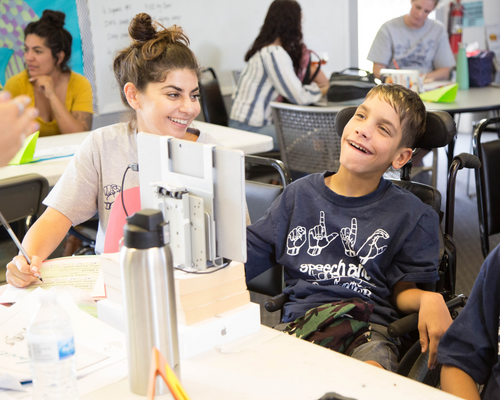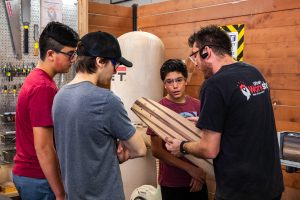From comic books to virtual reality, therapists and teachers look forward at innovations in special needs programs.
Parents of special needs kids know the particulars of a home life designed to suit their child. It often involves helping their child navigate the world.
Educators of special needs students — known as Resource Specialist Program teachers — have similar goals. Sometimes, with shifting resources and changing student needs. But they get through the best they can. So, a bit of ingenuity can pay off for educators and ultimately students. New tools and new methods can lead to real breakthroughs.
“I like to use materials students are interested in, like graphic novels, comics, games and digital resources, and craft projects to inspire and motivate my learners,” says RSP teacher Tannaz Ostadaghei about her language arts class at Warner Middle School in Westminster.
Ostadaghei also runs the Comic Book Collective, a club “open to all students, and students with special needs participate regularly. We have weekly discussions, students share their comic books with peers, and practice drawing and designing comics.”
Her group’s latest novel study is the 2012 book, “Wonder.”
“What I find successful is giving my students the opportunity to read a chapter in peer groups followed by a whole class discussion,” Ostadaghei says. “This works because I am able to visit each group and observe their reading and discussions. Our class discussions are enhanced because students have practiced in groups and are ready to share as a whole class, allowing for insightful and interesting conversations. Also, I provide students with novel study Google Slides, a ‘Wonder’ novel study paper packet and educational videos. Digital, paper and audio/visual methods have been very successful because I work with a variety of learners.”
And for the variety of learners, variety is the key.
“What I’ve found least successful is repeating and using the same tools and materials every week. Mix it up!” she says. “Try new activities, and ask your students for feedback so you can develop a learning environment that fits their needs best.”
Keeping Up With Innovations
For Unlimited Possibilities, a pediatric therapy nonprofit in Santa Ana, innovation often can’t come fast enough.
“We prioritize new programs or treatments for services within pediatrics,” says President and CEO Ramin Baschshi. And those new programs and treatments are typically implemented within a month, based on factors like funding or the amount of development it might require by staff.
“Constraint-induced movement therapy took about six months because it required certification,” Baschshi says. “Our team had to get certified out-of-state and develop a comprehensive program. We then began working with children from around California. To see the treatment become effective, it took three weeks.
“For something like Zero-G, which is completely brand-new equipment, it’s a funding issue. Then about nine months for the equipment to be developed, shipped and installed in our facility. This will be a brand-new treatment for us, so testing will probably be a 12-month process.”
The organization has also found input from student therapists valuable as a way to stay on the leading edge and ever-improving.
“During clinical rotations, students put together presentations on how to make the equipment or therapies better,” says Christina Lim Garkovich, vice president of philanthropy and marketing for Unlimited Possibilities. “A recent topic for discussion is incorporating virtual reality into our offerings. Therapists are using what they learned two to five years ago, but students are sharing the new innovative therapies they are seeing in the classroom and their own research. In healthcare, it’s a very long process for innovative therapies to be considered coverable. One of the hardest parts is getting funding or determining if insurance will cover new, innovative therapies and devices.”
Leilani Dap, occupational therapy manager for UP says she uses the research she gets not only from various associations and groups, but from the families of patients.
“I take their recommendations and do my own research to determine if it will work with the patients we serve. Virtual reality, the research indicates, would benefit the children who come to us. From there, each child is different, so they will each respond differently and at their own pace.”
Dap says she likes to immerse herself in the research, “from learning what other hospitals and clinics are using it for, as well as what types of patients it’s being used on and how patients are responding to it.”
Blending Old and New
Meredith Cagle runs Santa Ana’s Beyond Blindness programs and says one of the main challenges in RSP is “accommodating diverse learning styles, adapting teaching methods and materials to meet individual needs, and providing appropriate resources and support services. Special needs children may require additional assistance such as assistive technology, individualized instruction and adapted materials. Another challenge is helping them develop social and communication skills, and emotional regulation. Teachers must work to create a safe and productive learning environment for all students while also managing the unique needs of each child.”
“There are a lot of barriers that families have to navigate through. Whether it be issues with insurance or trying to get the right help through their school district,” she says. “Our kids have been through a lot and their journey is just barely beginning.”
Long-standing tools like Braille, tactile cues, screen readers and magnifiers continue to work in classrooms for visually impaired students, but educators are also now integrating a play-based, hands-on learning that includes dramatic play, technology and discovery centers, music, blocks, transportation play, library and art zones, indoors and out.
Cagle says her program works because the approach is “entirely inclusive,” which is key to student success. Students with disabilities often benefit from exposure to all types of learners. The interaction between different types of students, preps them for school life after Beyond Blindness, while the neurotypical students learn social skills, cooperative play and positive communication strategies.
Related Posts
- 4 Self-Care Tips For Special Needs Parents
- Why You Should Listen To Your Child And Recognize Early Signs For Special Needs
- Local Therapist and Mom’s Tips to Minimize Sensory Overload Among Neurodivergent Children
“However,” Cagle says, “the most unexpected and underrated effect of combining students with learning differences is the deep bond and lifelong friendships that develop.”
While inclusive and innovative methods have been successful, Amber Purcell, a preschool teacher at Beyond Blindness, knows what won’t work in her classroom.
“Punitive or overly stringent approaches have the least successful outcomes for students with disabilities. We have learned that skills scaffolding with a strong emphasis on celebrating even the smallest of developmental goals, goes a very long way. Another component that isn’t compatible is lack of routine or schedule. Our students thrive in structured environments, and we do our best to meet that need by front-loading any changes to our schedule well in advance,” she says.
A balance in words is as important as a balance of actions, says Adrienne Kessler, CEO of Buena Park’s Speech and Language Development Center.
“Too much language!” she says. “Our society often defaults to more words. If we are not being understood, we often say things again, say it louder, over and over again, speak faster. For individuals with special needs, they may benefit from a few extra seconds to comprehend what was just said before being able to respond. And avoid multiple people speaking to them at the same time.”
And when success occurs, it isn’t always instant.
“Evaluating effectiveness can take months,” Purcell says. “For instance, when a student who is struggling to sit upright slowly develops the core strength needed to do so. Because Beyond Blindness has two onsite physical therapy rooms, we can apply a wide variety of techniques requiring specialized equipment to accomplish the best outcome. But the equipment that is most useful for one student may be ineffective for another and finding the right fit is part of that journey.”
While some use comic books to break through, others use tech or broader approaches.
But Purcell says their “Creative Curriculum” was one of those immediate hits, using “award-winning early literature that builds STEM, art, music and phonological activities around a featured book. The curriculum may indicate a read-aloud of ‘The Three Billy Goats Gruff’ and incorporate counting songs, art activities, science experiments and math lessons that reference the book. Additionally, even theme-based toys are added to classroom centers to further enhance learning. Within the first few weeks, our students were discussing the books and activities enthusiastically at home and school.”
Garkovich touts UP’s success with constraint-induced movement therapy. “It works,” she says, “because it’s been clinically proven, when you cast an ineffective limb to force the enhancement of the affected limb to be stronger.”
While Dap likes the success they’ve had with VitalStim Therapy, “particularly helping our patients swallow. We’re able to place electrodes on a child’s throat, and this little bit of sensation helps them recognize the feeling of swallowing and when to do it. With time, some patients will begin to naturally trigger their swallow response to prevent food from going into their lungs. Without these sensations, they may have a delayed reaction, which could cause serious harm.”
Kessler believes the breakthroughs are more about a general approach to special education.
“I don’t know if this is necessarily ‘new,’ but moving away from canned curriculums, and focusing on meaningful skills with generalized applications is the most effective for learning,” she says. “Focusing on skill acquisition that has value to the individual who is learning it will drive their motivation. By selecting skills useful to the individual learner and then making them applicable across home, school or community environments is what changes the quality of life for the individual. The innovation here is knowing what a valuable skill is and prioritizing accordingly.”
Despite these successes, what would make their wish lists?
“Virtual reality should definitely be considered for use because the data supports that this is beneficial,” Baschshi says. Garkovich agrees.
Dap says a sensory gym would top her list. “It might be therapeutic, but it looks like a playground. It encompasses every child’s physical therapy needs while also encouraging their natural inclination to play.”
Purcell says special education programs should ideally appeal to “each of our human senses. By providing hands-on opportunities to touch, taste, hear, smell and see what they are learning about, we give every type of learner the opportunity to participate and succeed.”
By Shawn Price









